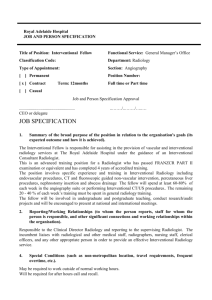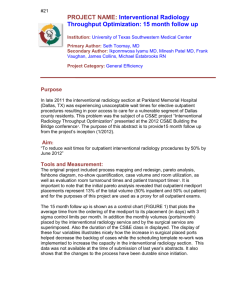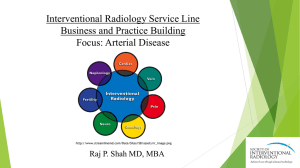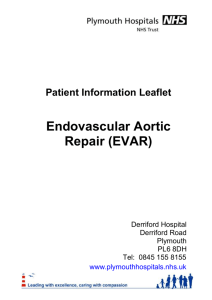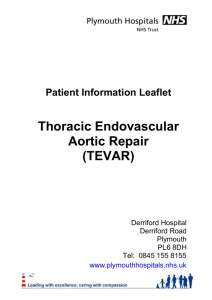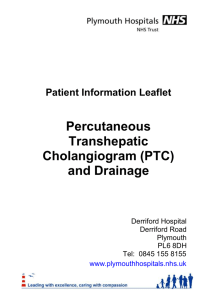PowerPoint Presentation - Interventional Radiology
advertisement
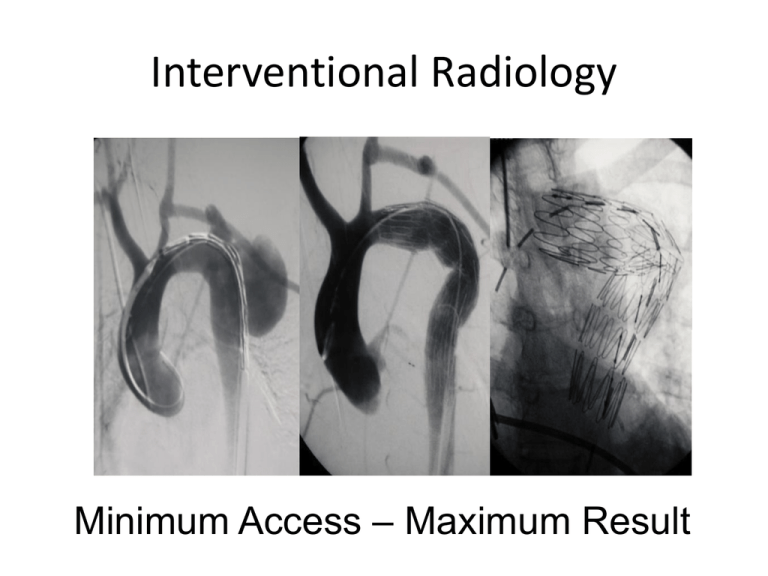
Interventional Radiology Minimum Access – Maximum Result Interventional Radiology is pin hole surgery performed with the aid of X rays, CT and ultrasound by specially trained doctors called Interventional Radiologists 8 out of 10 procedures use skin incisions smaller than 5 millimetres 9 out of 10 procedures use only local anaesthetic, sometimes with sedation Up to 8 out of 10 patients go home the same day And it’s often a less invasive option than traditional surgical procedures Targeted cancer treatment Aortic aneurysms Blocked bile ducts Blocked kidneys Internal Bleeding Fibroids We treat many conditions....... Here are just a few Dialysis Blocked arteries Varicose veins Bone and spine Leg arteries Blood clots Blood vessel malformations Scope of Interventional Radiology Blood Vessel Bleeding control Cancer Many other treatments Blood Vessels Treats blood vessels from 2 mm to 30 mm Narrowed blood vessels are stretched (Angioplasty) to improve blood flow Blocked blood vessels can be internally reopened in many cases Treatment of aneurysms (abnormal bulges in vessels). Unblocking arteries Blocked arm artery (Arrow) causing pain and arm weakness Treated by internally unblocking the artery and placing a stent Major surgery avoided. Total treatment time of one hour Aortic Aneurysm Abnormal bulge (aneurysm) of the main artery in the abdomen Risk of rupture and major bleeding Treated by internally relining the artery (Endovascular aneurysm repair-EVAR) Major surgery avoided. Total treatment time of 90 minutes Cancer Treatment Symptom relief • Thermal destruction of small cancers using image guided needles • Stent insertion into the bowel for relief of obstruction • Targeted chemotherapy into blood vessels supplying the tumour • Insertion of lines for delivery of chemotherapy and nutrition Cancer Treatment Small cancer lesion in the liver (arrow) in a patient with previously treated cancer Image guided thermal destruction Surgery and chemotherapy avoided. Treatment time of 60 minutes. Bleeding Control Key emergency role for Interventional Radiology Treatment of bleeding from Trauma, bowel, child birth or following surgery Blood vessels as small as 2-3mm can be treated Blood vessels can be blocked (embolisation) or relined with a stent depending on the location and need Bleeding into Bowel Severe bleeding into the large bowel (arrow) Treated with selective Blockage of the bleeding Artery Emergency surgery avoided Other Treatments Bone Dialysis Liver and Bile ducts Fibroids Kidneys Too many procedures...too little space For more detailed patient information and further information about Interventional Radiology please visit www.bsir.org & www.bsir-qi.org Interventional Radiology Minimal access Local anaesthesia/sedation Quicker recovery Less invasive alternative Prepared on behalf of British Society of Interventional Radiology by Dr G Ananthakrishnan and Dr I Robertson



